Winnipeg is the capital and largest city of Manitoba, which along with Alberta and Saskatchewan are Canada’s prairie provinces. As the administrative center you can see the provincial government buildings in the city, which also has many other sights.
In architectural and cultural history, Winnipeg ranges from the city’s early years and constructions to modern buildings. The beginning of the 20th century is represented by Manitoba Club and Fort Garry Hotel, while the Canadian Museum of Human Rights stands as one of the city’s newer monuments of architecture.
There is a lot of culture and sports in Winnipeg, which hosts several annual festivals such as the Winnipeg Folk Festival and Jazz Winnipeg Festival. You can also see large sporting events with local teams in eg. ice hockey, baseball, football and Canadian football.
Winnipeg is charming and it is a city known in Canada as one of the main cities of gastronomy. Amongst the many sights there is an large selection of restaurants that await visitors with fine flavors and memorable cuisines.
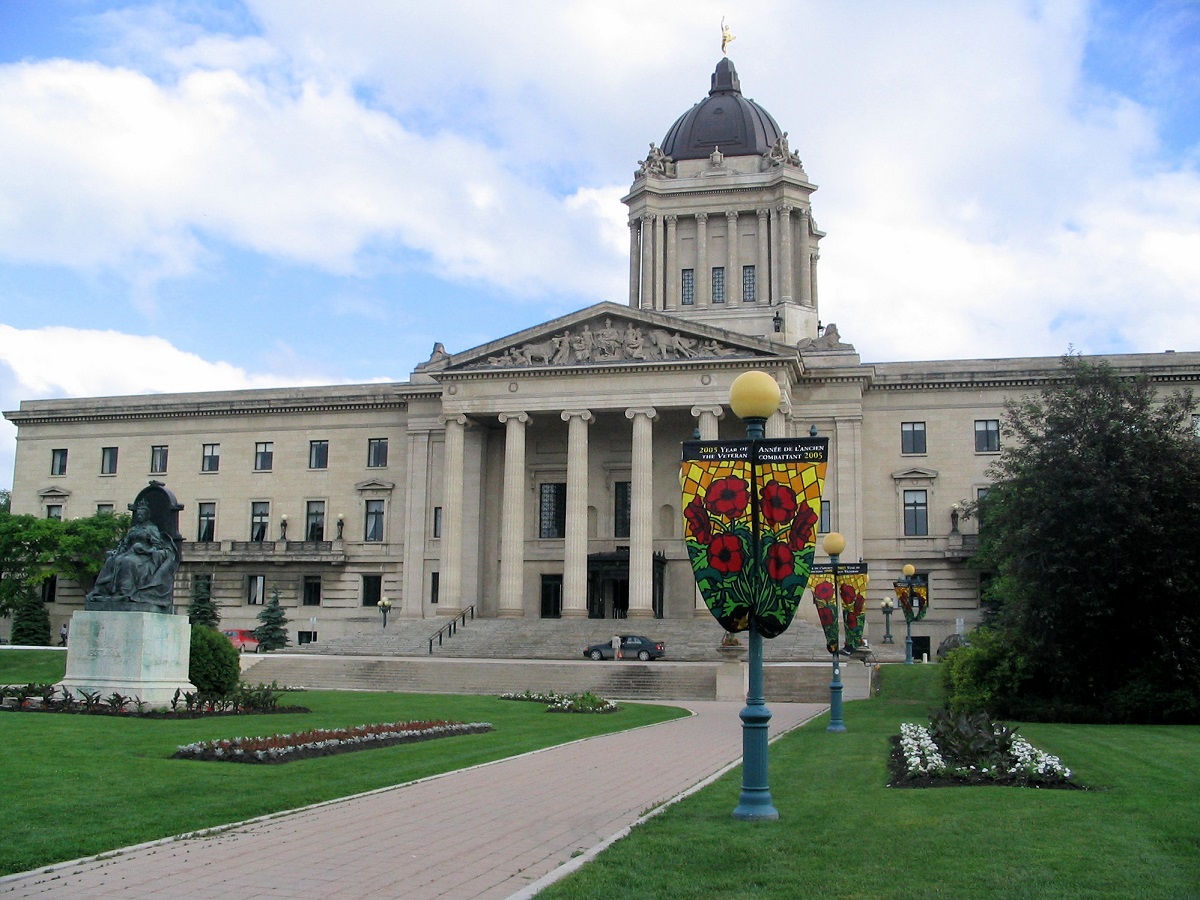
The Legislative Building is the province of Manitoba’s beautiful parliament building, built in the Beaux Arts style in the years 1913-1920. It is the city’s most imposing public building, and it was also intended from the start that it should be a symbol of Winnipeg’s and Manitoba’s ability.
As Parliament House, the structure is the seat of Manitoba’s legislature, and the province’s premier and the monarch’s representative are among those who have offices here. This makes the Legislative Building the political center of Manitoba.
The Legislative Building is the third parliament building in Winnipeg. It was largely built, as the province’s population and economy had multiplied over the previous decades, when a new construction was decided upon in 1909. After an architectural competition in 1911, Frank Worthington Simon’s proposal was chosen as the winner.
The building is 74 meters high and on top of its dome is a gilded statue of the Roman god Mercury, the statue is also known as The Golden Boy and is a symbol of Manitoba. The dome stands centrally on the building, which has an H shape of 103×100 meters, and just below the dome you can see four statues representing industry, art, agriculture and science.
Inside, there are many beautifully decorated rooms and halls in the Legislative Building. This concerns, for example, the Rotunda, where in the middle you can see a balustrade that opens to the Pool of the Black Star on the floor below. There is an eight-pointed marble star that lies directly below The Golden Boy at the top of the dome.
Riel House is the name of a house that was once the residence of the famous Métis leader, Louis Riel, who founded Manitoba. Louis Riel lived in the house with his family from 1868-1870, and it was also here that he lay two days after his execution in 1885, before being buried.
The beautiful little house remained in the ownership of the Riel family until 1968, when it was acquired by the Winnipeg Historical Society, who wanted to preserve the historically interesting house. Riel House was then brought back to its interior in 1886 and opened as a museum.
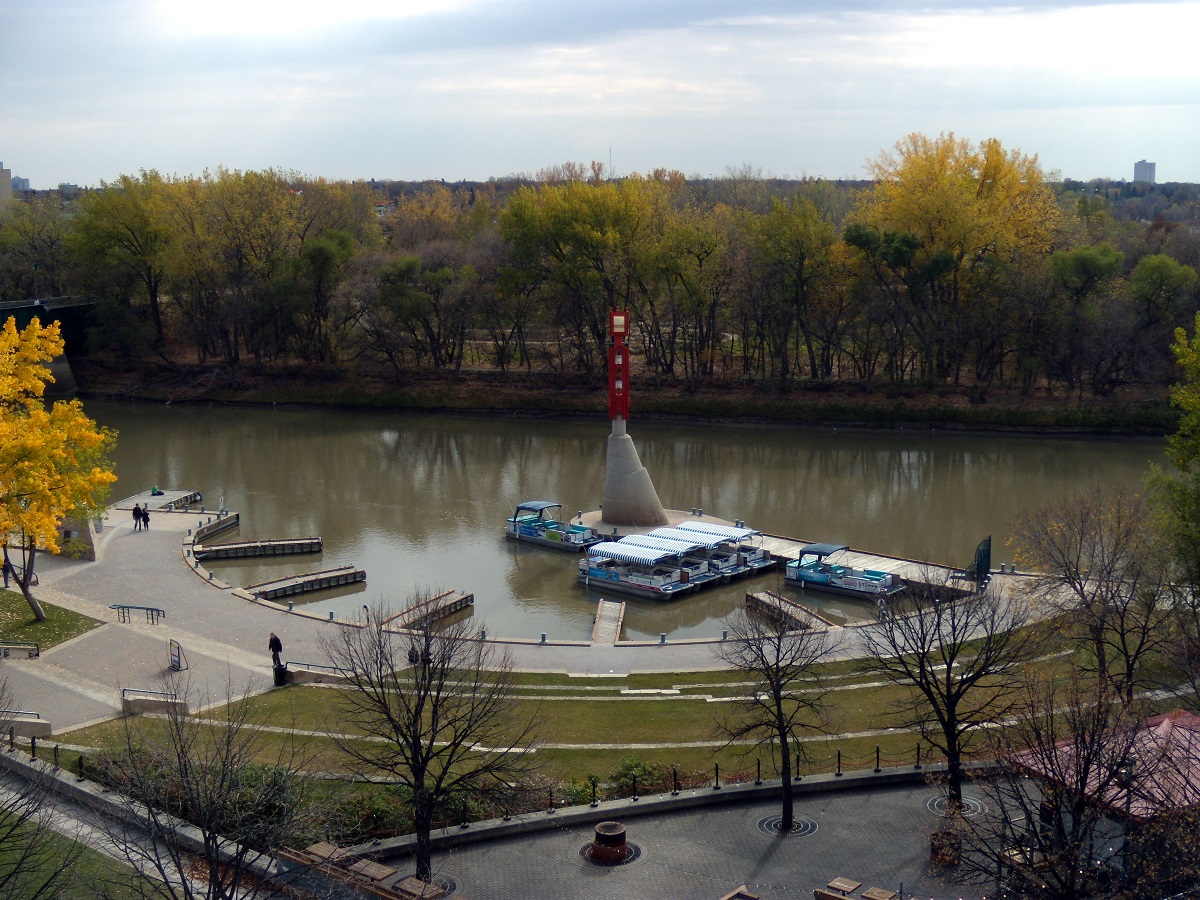
The Forks National Historic Site is a cultural historic site located at The Forks, the confluence of the Red River and Assiniboine River. The place was already used as a meeting and trading place 6,000 years ago, when the original Canadian population could sail here easily along the rivers.
Today, there are many activities in the area that the original population used for millennia. It was also here that Europeans established Fort Rouge and The Red River Colony. The fur trade also took place at this location, where both the Hudson’s Bay Company and the North West Company had warehouses and other facilities.
The Forks is about five hectares in size, where you can take a walk to experience the cultural history or today’s shops, restaurants and other activity opportunities. You can also look at some preserved buildings from the area’s industrial and railway era, such as the old sheds, where The Forks Market is located today.
There are also several museums and other institutions in The Forks. These include the Manitoba Children’s Museum, which is popular for families with children, the Shaw Performing Arts Center theatre, the Canadian Museum for Human Rights and the Winnipeg Railway Museum, located in the city’s historic Union Station. There are also quite a few outdoor activities.
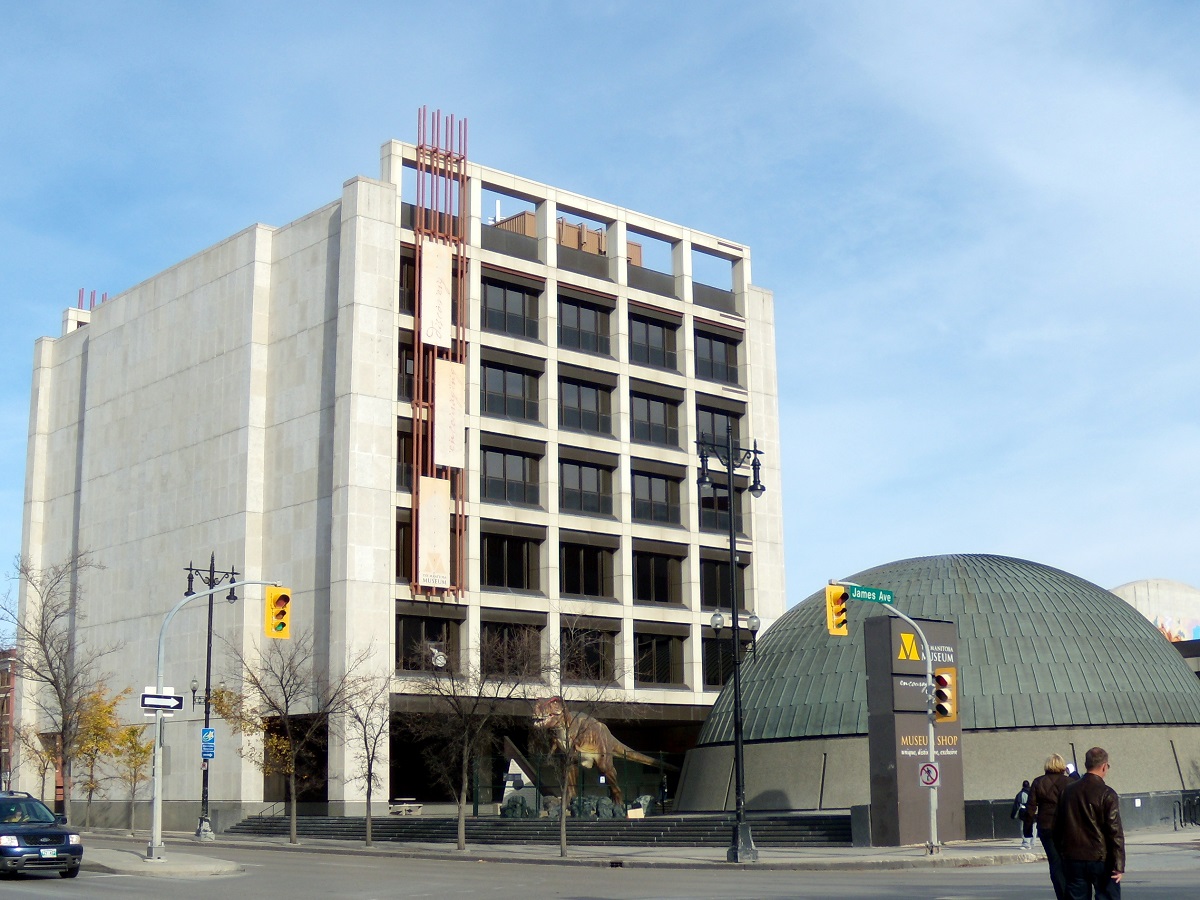
The Manitoba Museum is, so to speak, the national museum of the province of Manitoba, and the collection elegantly describes the culture and nature of all regions from north to south. Here are many exciting depictions and effects. Among them is a replica of the ship Nonsuch, whose voyage in 1668 led to the establishment of the Hudson’s Bay Company, which in 1994 donated its collections to the museum.
In 1879, The Historical and Scientific Society of Manitoba began collecting and preserving the province’s cultural heritage. That work ended with the opening of the Manitoba Museum in 1932 in the current Archives of Manitoba Building. The collections are colossal today, and a visit to the museum can see thematic exhibitions such as The Earth History Gallery, The Winnipeg Gallery and The Prairies Gallery.
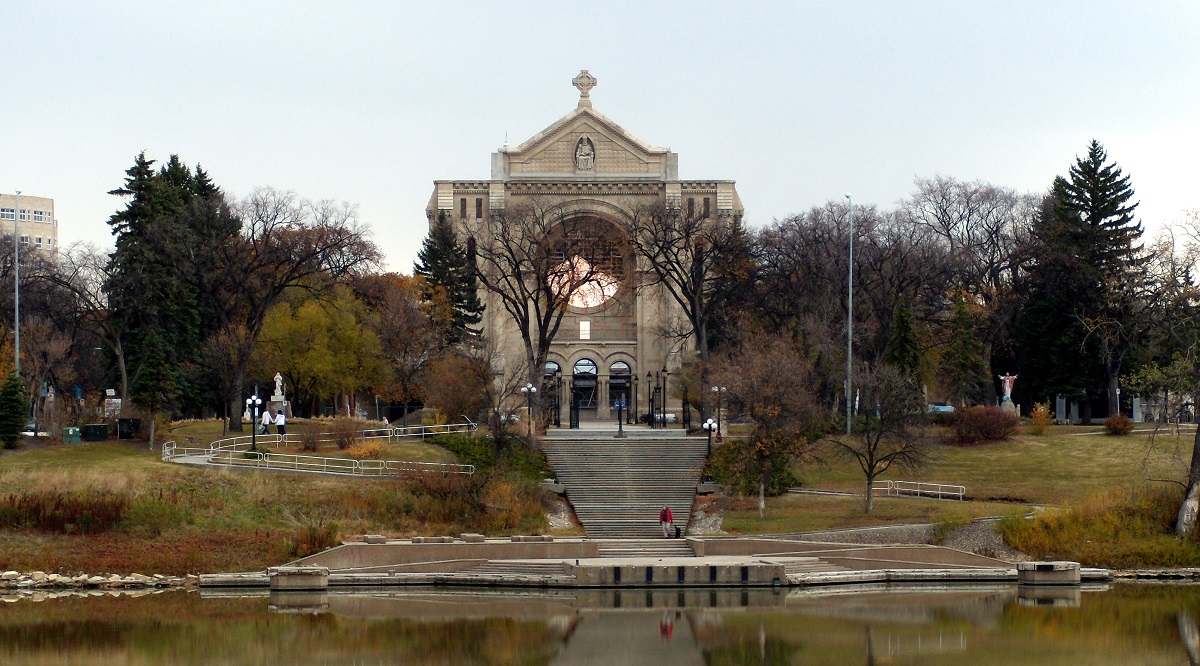
St. Boniface Cathedral is one of Winnipeg’s more quirky and architecturally intriguing landmarks. In the middle of the ruins of a former church building from 1908 lies the modern cathedral that you can see today. The old church towers have perished, but the impressive facade has been preserved, and behind it is the current church.
The history of the cathedral began in 1818, when the priest Norbert Provencher and two colleagues built a small church on the banks of the Red River on a piece of land that the Hudson’s Bay Company’s Thomas Douglas. The small building was both church, school and residence, and within a few years it was replaced by a larger church.
Norbert Provencher became bishop, and he built the first cathedral on the site in 1832. In 1860, the church burned, and therefore Bishop Taché traveled to Québec to find funds for a new stone construction. It succeeded, and the church was built in the 1860s, but it soon became small. For that reason, one of Western Canada’s largest churches was dedicated in 1906 as a new cathedral.
In 1968, the church burned down, so only part of the facade and walls remained. They then chose to integrate a modern construction, which was built in 1972 according to Étienne Gaboury and Denis Lussier’s design. It is an experience to see the contrasts between 1906 and 1972, and you can also see the cathedral’s burial place for Louis Riel.
Ross House Museum is a museum located in the wooden house Ross House. The house was built in the years 1852-1855, and in addition to being the residence of the Ross family, it also served as the first post office west of the Great Lakes in eastern Canada.
The house stood on the banks of the Red River at what is now Market Avenue, but with the development of Winnipeg, the Ross House was gradually threatened with demolition. The Manitoba Historical Society saved the house in 1947 by moving and renovating it. It was again moved in 1984 to its current location.
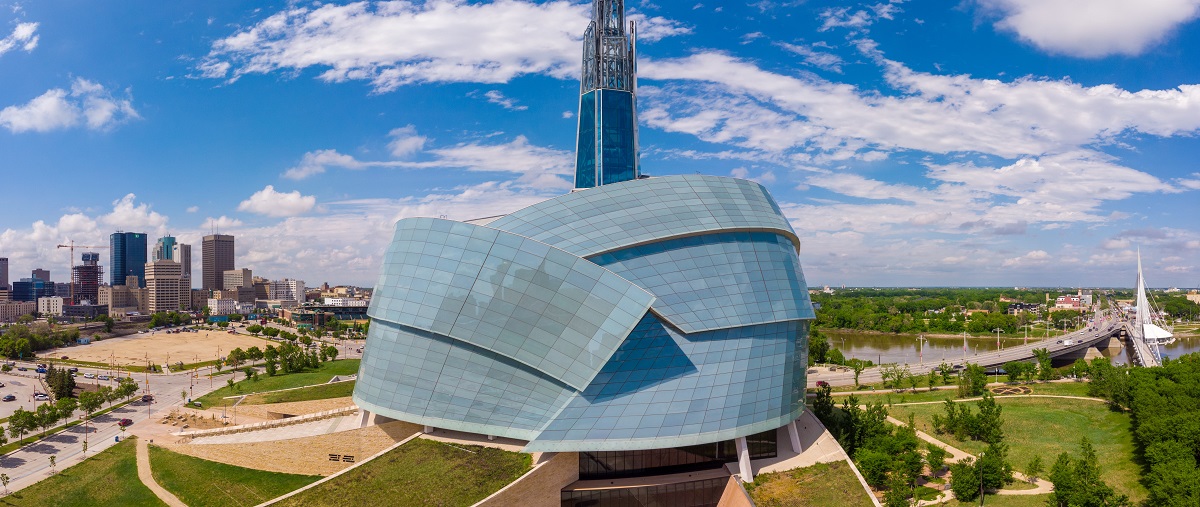
The Canadian Museum for Human Rights is a Canadian national museum for human rights, which was established in Winnipeg in 2008. The architecturally exciting building depicts various aspects of human rights in and outside of Canada.
The foundation stone for the architecturally exciting museum building was laid in 2008, and the museum was inaugurated in 2014. On a visit, you can enjoy the construction in, among other things, the Great Hall and the 100-metre-high Tower of Hope, from which there is a fine view of downtown Winnipeg.
The exhibitions have different themes. There are special exhibitions on, for example, the perspectives of Canada’s indigenous population and the Canadian development in the field of human rights. There are also depictions of the events in history that Canada recognizes as genocide.
The Seven Oaks House Museum is a museum in what is possibly the oldest inhabited house in the province of Manitoba. It was built 1851-1853 with, among other things, stone, oak and buffalo hair as building materials. The house was built without the use of architects or craftsmen by John Inkster.
Today, the house is set up as a museum, where you can experience interiors from the 1800s and get an insight into the daily life of the time. As part of the museum you can also see Inkster’s General Store, which is a log house that was last built in 1831 by John Inkster. Housed in Winnipeg’s oldest building, it was originally a residence before being converted into a store and post office.
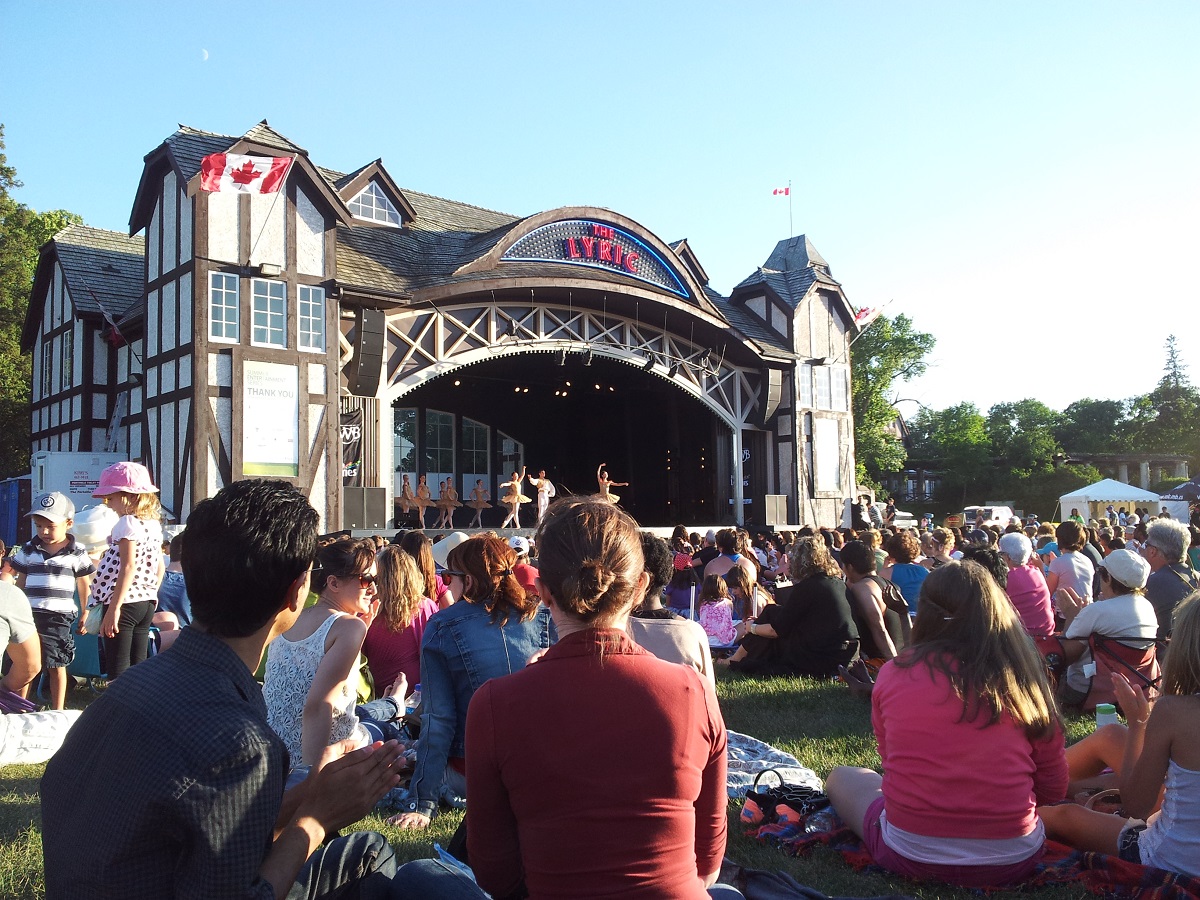
Assiniboine Park is a green space that is popular among Winnipeg residents for its beautiful and varied nature and the wide range of activities available during a visit. There is, among other things, a conservatory, a stage, a zoo and a mini railway.
Assiniboine Park is located along the Assiniboine River, and the city park administration acquired an area to establish the park in 1904. The park opened in 1909 with a large area designed as an English landscape garden. One of the architectural landmarks is the Assiniboine Park Pavilion from 1930, which is designed as a museum and gallery.
You can also visit The Lyric Theatre, which is an outdoor stage next to the pavilion. It is also worth a visit to the Assiniboine Park Conservatory, a botanical garden with many beautiful plants. The Assiniboine Park Zoo opened in the area in 1908, and of course the gardens also attract many visitors, as does the miniature Assiniboine Park Railroad.
Esplanade Riel is a pedestrian bridge named after Métis leader Louis Riel. Spanning the Red River, the bridge opened in 2004 as the first bridge in North America with a restaurant located on the bridge itself as part of the design and construction.
The elegant design was created by Guy Préfontaine and Étienne Gaboury. The bridge was built together with the adjacent road bridge, the Provencher Bridge, as a unified link over the Red River, and the Esplanade Riel is today one of Winnipeg’s landmarks.
Union Station is Winnipeg’s old main railway station, built in beautiful beaux-arts style in 1908-1911. Architects Warren and Wetmore designed the railway station, which was built in local Tyndall limestone. The facade along Main Street is 110 meters long, and Union Station also opened as one of western Canada’s largest stations.
It was the companies Canadian Northern Railway, National Transcontinental and Grand Trunk Pacific Railway that came together and built Union Station as a unifying main railway station. The railway station was for many years an important hub between eastern and western Canada, and trains also ran to the Minneapolis-St. Paul in the United States.
Today, trains still run to the station, which is a stop between Toronto and Vancouver, and you can also take the train to Churchill, for example. Parts of the station building have, however, been newly furnished with various offices. You can still see the beautiful Main Hall and then you can visit the Winnipeg Railway Museum.
Lower Fort Garry National Historic Site is a place of historical interest located northeast of Manitoba’s capital Winnipeg. Lower Fort Garry was a fort built by the Hudson’s Bay Company in 1830 on the west bank of the Red River. It happened in the years after the original Fort Garry was flooded and destroyed.
The first buildings on the fort in 1830 were some that housed the company’s store, warehouse, and trading office, as well as housing the governor of the Hudson’s Bay Company or other high-ranking officials. Later, Lower Fort Garry was expanded with other facilities and the walls of the fort. The fort was a trading post, but its primary purpose was to secure supplies for the area’s settlements.
Lower Fort Garry was owned by the Hudson’s Bay Company until 1951, when it was transferred to the federal government of Canada. Seven years later it was given the status of a National Historic Site, and today it is open as an open-air museum, where you can both see the fort itself and experience life at the fort as it unfolded in the 1850s.
Brandon is the second largest city in the province of Manitoba. It is located on the banks of the Assiniboine River between the provincial capital Winnipeg and the Saskatchewan border. Historically, the town has been important for the fur trade on the river and as a railway junction, while today it is located in an important agricultural area with large grain production.
There are several buildings worth seeing in the center of Brandon, and you can also visit some museums such as the Art Gallery Of Southwestern Manitoba, which is a museum of modern art, and the city museum Brandon General Museum and Archives. In the city, for example, you can take a walk along Princess Avenue, where you can see buildings such as the Central Fire Station from 1911 and the Brandon Court House from 1910.
Gimli is a small town beautifully situated on the western shore of Lake Winnipeg in the province of Manitoba. It was an area where Icelanders settled as the first Europeans. They did so from 1875 in what they called Nýja Ísland or New Iceland, and Gimli’s population lived not least from agriculture and fishing.
In 1906, the Canadian Pacific Railway opened a railway between Winnipeg and Gimli, making the small town a popular excursion destination from the provincial capital. Later, cabins were built along the lakeshore, which became a popular recreational area. It is still the city, and you can both swim from the city’s beach and see Gimli’s harbor on a visit.
In Gimli you can also visit the Gimli Glider Museum, which is an interactive exhibit about the amazing emergency landing that was made at Gimli’s otherwise defunct airport with a Boeing 767 in 1983. The plane had run out of fuel and the pilot landed the big plane as a glider.
Hecla-Grindstone Provincial Park is a natural area in the province of Manitoba. The park consists not least of Hecla Island and other islands in Lake Winnipeg. Hecla Island was laid out as a nature park in 1969, and in 1997 the area of Grindstone Provincial Park on the Canadian mainland became part of the park, which thus got its current name.
On Hecla Island there are campsites and other accommodations from which you can enjoy nature. The landscapes in the park are varied and include areas of coniferous and mixed forests, limestone cliffs, sandy beaches, meadows and more. In the north-eastern part of Hecla Island, there is also a golf course and other activity opportunities.
St. Mary Avenue
cityplacewinnipeg.com
1555 Regent Avenue W
kildonanplace.com
1485 Portage Avenue
polopark.ca
392 Portage Avenue
portageplace.mb.ca
1225 St. Mary Avenue
stvitalcentre.com
Academy Road, Osborne Street, Exchange District
Manitoba Children’s Museum
45 Forks Market Road
childrensmuseum.com
Prairie Dog Central
1 Prairie Dog Trail
pdcrailway.com
Winnipeg Railway Museum
123 Main Street
wpgrailwaymuseum.com
Winnipeg Fire Service Museum
56 Maple Street
winnipegfiremuseum.ca
Western Canada Aviation Museum
958 Ferry Road
wcam.mb.ca
Assiniboine Park Zoo
2595 Roblin Boulevard
zoosociety.com
Winnipeg’s past history with European residents was dominated by a lucrative fur trade that the North West Company stood for. It was such a lucrative business that until 1821 the organization physically disposed of immigrants who did not start cultivating the area or taking part of the trade from the established business.
In 1821, the North West Company and the rival Hudson’s Bay Company agreed that an increased settlement could take place, and it attracted many settlers.
At the beginning of Winnipeg’s time as a city, it was referred to as the Red River Settlement, Assiniboia. In 1866, the local newspaper, The Nor’wester, then wrote the name Winnipeg, which derives from the two words “win” and “nipee”. The words are from the original Canadian population and they mean the place with muddy water.
The settlers’ farming began from the 1840s to be solid enough to make them a little less dependent on the all-dominant fur trade. However, the 1870s still had to go before a larger volume was found. In 1871 there were only 215 people living, but already three years later there were 3,700.
Over time, several small settlements along the Red River have emerged. The Forks and Selkirk. In addition to the settlers, there was a population group, the Métis people, who were a mix of early Europeans and the original Canadian population. The Métis people wanted to secure their rights to not least the land of the area, and that led to an uprising led by Louis Riel.
Riel founded Manitoba and joined Canada as a new province. As a Canadian province, land acquisition from the Hudson’s Bay Company could begin, thereby securing the land for the new province and its people instead of a commercial owner. Manitoba joined Canada in 1870 and Winnipeg became the regional center. In 1873, The Forks merged with Winnipeg, and it was the first major part of the city’s expansion.
Many new inhabitants came in the following decades. In 1891, the city numbered 25,000 in population, and it exploded to 200,000 in 1921. During this boom period, there was almost no end to the city’s ambitions, and this is best seen in the construction of the Legislative Building, which was completed in 1920.
Over the following decades, the growth slowed to resume after World War II. However, it did not take long for a temporary halt to development. In 1950, eight high tide dikes collapsed in the Red River. Winnipeg was flooded, several of the city’s bridges were destroyed and 75,000 people had to be evacuated. The city received assistance from the federal government and subsequently measures were taken to avoid a similar situation in the future.
Today, Winnipeg is a charming and vibrant city, known in Canada as one of the gastronomic metropolitan cities. Amongst many sights there is a very large selection of restaurants and visitors await.

Overview of Winnipeg
Winnipeg is the capital and largest city of Manitoba, which along with Alberta and Saskatchewan are Canada’s prairie provinces. As the administrative center you can see the provincial government buildings in the city, which also has many other sights.
In architectural and cultural history, the city ranges from the early years and constructions to modern buildings. The beginning of the 20th century is represented by Manitoba Club and Fort Garry Hotel, while the Canadian Museum of Human Rights stands as one of the city’s newer monuments of architecture.
About the upcoming Winnipeg travel guide
About the travel guide
The Winnipeg travel guide gives you an overview of the sights and activities of the Canadian city. Read about top sights and other sights, and get a tour guide with tour suggestions and detailed descriptions of all the city’s most important churches, monuments, mansions, museums, etc.
Winnipeg is waiting for you, and at vamados.com you can also find cheap flights and great deals on hotels for your trip. You just select your travel dates and then you get flight and accommodation suggestions in and around the city.
Read more about Winnipeg and Canada
Buy the travel guide
Click the “Add to Cart” button to purchase the travel guide. After that you will come to the payment, where you enter the purchase and payment information. Upon payment of the travel guide, you will immediately receive a receipt with a link to download your purchase. You can download the travel guide immediately or use the download link in the email later.
Use the travel guide
When you buy the travel guide to Winnipeg you get the book online so you can have it on your phone, tablet or computer – and of course you can choose to print it. Use the maps and tour suggestions and you will have a good and content-rich journey.
Forks Historic Site • Riel House • Heritage • Manitoba Museum

Overview of Winnipeg
Winnipeg is the capital and largest city of Manitoba, which along with Alberta and Saskatchewan are Canada’s prairie provinces. As the administrative center you can see the provincial government buildings in the city, which also has many other sights.
In architectural and cultural history, the city ranges from the early years and constructions to modern buildings. The beginning of the 20th century is represented by Manitoba Club and Fort Garry Hotel, while the Canadian Museum of Human Rights stands as one of the city’s newer monuments of architecture.
About the upcoming Winnipeg travel guide
About the travel guide
The Winnipeg travel guide gives you an overview of the sights and activities of the Canadian city. Read about top sights and other sights, and get a tour guide with tour suggestions and detailed descriptions of all the city’s most important churches, monuments, mansions, museums, etc.
Winnipeg is waiting for you, and at vamados.com you can also find cheap flights and great deals on hotels for your trip. You just select your travel dates and then you get flight and accommodation suggestions in and around the city.
Read more about Winnipeg and Canada
Buy the travel guide
Click the “Add to Cart” button to purchase the travel guide. After that you will come to the payment, where you enter the purchase and payment information. Upon payment of the travel guide, you will immediately receive a receipt with a link to download your purchase. You can download the travel guide immediately or use the download link in the email later.
Use the travel guide
When you buy the travel guide to Winnipeg you get the book online so you can have it on your phone, tablet or computer – and of course you can choose to print it. Use the maps and tour suggestions and you will have a good and content-rich journey.

St. Boniface Cathedral is one of Winnipeg’s more quirky and architecturally intriguing landmarks. In the middle of the ruins of a former church building from 1908 lies the modern cathedral that you can see today. The old church towers have perished, but the impressive facade has been preserved, and behind it is the current church.
The history of the cathedral began in 1818, when the priest Norbert Provencher and two colleagues built a small church on the banks of the Red River on a piece of land that the Hudson’s Bay Company’s Thomas Douglas. The small building was both church, school and residence, and within a few years it was replaced by a larger church.
Norbert Provencher became bishop, and he built the first cathedral on the site in 1832. In 1860, the church burned, and therefore Bishop Taché traveled to Québec to find funds for a new stone construction. It succeeded, and the church was built in the 1860s, but it soon became small. For that reason, one of Western Canada’s largest churches was dedicated in 1906 as a new cathedral.
In 1968, the church burned down, so only part of the facade and walls remained. They then chose to integrate a modern construction, which was built in 1972 according to Étienne Gaboury and Denis Lussier’s design. It is an experience to see the contrasts between 1906 and 1972, and you can also see the cathedral’s burial place for Louis Riel.
Ross House Museum is a museum located in the wooden house Ross House. The house was built in the years 1852-1855, and in addition to being the residence of the Ross family, it also served as the first post office west of the Great Lakes in eastern Canada.
The house stood on the banks of the Red River at what is now Market Avenue, but with the development of Winnipeg, the Ross House was gradually threatened with demolition. The Manitoba Historical Society saved the house in 1947 by moving and renovating it. It was again moved in 1984 to its current location.

The Canadian Museum for Human Rights is a Canadian national museum for human rights, which was established in Winnipeg in 2008. The architecturally exciting building depicts various aspects of human rights in and outside of Canada.
The foundation stone for the architecturally exciting museum building was laid in 2008, and the museum was inaugurated in 2014. On a visit, you can enjoy the construction in, among other things, the Great Hall and the 100-metre-high Tower of Hope, from which there is a fine view of downtown Winnipeg.
The exhibitions have different themes. There are special exhibitions on, for example, the perspectives of Canada’s indigenous population and the Canadian development in the field of human rights. There are also depictions of the events in history that Canada recognizes as genocide.
The Seven Oaks House Museum is a museum in what is possibly the oldest inhabited house in the province of Manitoba. It was built 1851-1853 with, among other things, stone, oak and buffalo hair as building materials. The house was built without the use of architects or craftsmen by John Inkster.
Today, the house is set up as a museum, where you can experience interiors from the 1800s and get an insight into the daily life of the time. As part of the museum you can also see Inkster’s General Store, which is a log house that was last built in 1831 by John Inkster. Housed in Winnipeg’s oldest building, it was originally a residence before being converted into a store and post office.

Assiniboine Park is a green space that is popular among Winnipeg residents for its beautiful and varied nature and the wide range of activities available during a visit. There is, among other things, a conservatory, a stage, a zoo and a mini railway.
Assiniboine Park is located along the Assiniboine River, and the city park administration acquired an area to establish the park in 1904. The park opened in 1909 with a large area designed as an English landscape garden. One of the architectural landmarks is the Assiniboine Park Pavilion from 1930, which is designed as a museum and gallery.
You can also visit The Lyric Theatre, which is an outdoor stage next to the pavilion. It is also worth a visit to the Assiniboine Park Conservatory, a botanical garden with many beautiful plants. The Assiniboine Park Zoo opened in the area in 1908, and of course the gardens also attract many visitors, as does the miniature Assiniboine Park Railroad.
Esplanade Riel is a pedestrian bridge named after Métis leader Louis Riel. Spanning the Red River, the bridge opened in 2004 as the first bridge in North America with a restaurant located on the bridge itself as part of the design and construction.
The elegant design was created by Guy Préfontaine and Étienne Gaboury. The bridge was built together with the adjacent road bridge, the Provencher Bridge, as a unified link over the Red River, and the Esplanade Riel is today one of Winnipeg’s landmarks.
Union Station is Winnipeg’s old main railway station, built in beautiful beaux-arts style in 1908-1911. Architects Warren and Wetmore designed the railway station, which was built in local Tyndall limestone. The facade along Main Street is 110 meters long, and Union Station also opened as one of western Canada’s largest stations.
It was the companies Canadian Northern Railway, National Transcontinental and Grand Trunk Pacific Railway that came together and built Union Station as a unifying main railway station. The railway station was for many years an important hub between eastern and western Canada, and trains also ran to the Minneapolis-St. Paul in the United States.
Today, trains still run to the station, which is a stop between Toronto and Vancouver, and you can also take the train to Churchill, for example. Parts of the station building have, however, been newly furnished with various offices. You can still see the beautiful Main Hall and then you can visit the Winnipeg Railway Museum.
Similar to Winnipeg Travel Guide